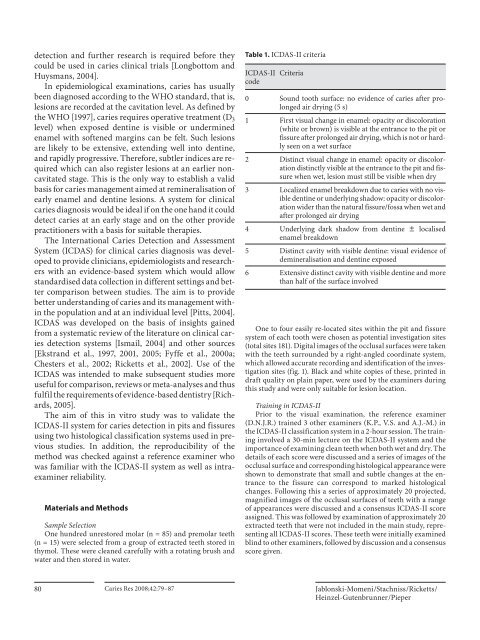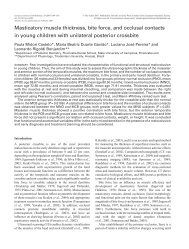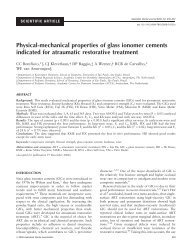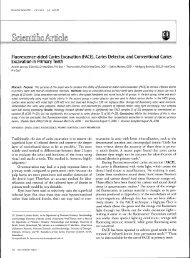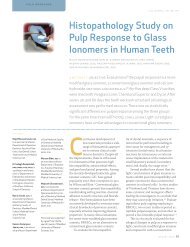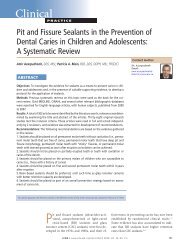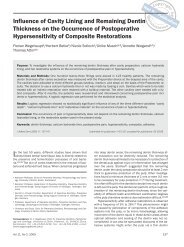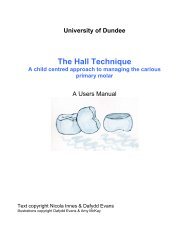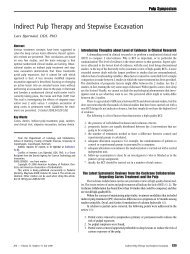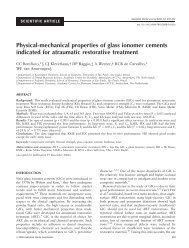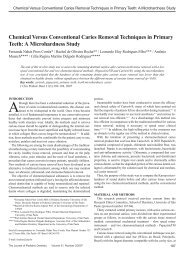View - Sandra Kalil Bussadori
View - Sandra Kalil Bussadori
View - Sandra Kalil Bussadori
You also want an ePaper? Increase the reach of your titles
YUMPU automatically turns print PDFs into web optimized ePapers that Google loves.
detection and further research is required before they<br />
could be used in caries clinical trials [Longbottom and<br />
Huysmans, 2004].<br />
In epidemiological examinations, caries has usually<br />
been diagnosed according to the WHO standard, that is,<br />
lesions are recorded at the cavitation level. As defined by<br />
the WHO [1997], caries requires operative treatment (D 3<br />
level) when exposed dentine is visible or undermined<br />
enamel with softened margins can be felt. Such lesions<br />
are likely to be extensive, extending well into dentine,<br />
and rapidly progressive. Therefore, subtler indices are required<br />
which can also register lesions at an earlier noncavitated<br />
stage. This is the only way to establish a valid<br />
basis for caries management aimed at remineralisation of<br />
early enamel and dentine lesions. A system for clinical<br />
caries diagnosis would be ideal if on the one hand it could<br />
detect caries at an early stage and on the other provide<br />
practitioners with a basis for suitable therapies.<br />
The International Caries Detection and Assessment<br />
System (ICDAS) for clinical caries diagnosis was developed<br />
to provide clinicians, epidemiologists and researchers<br />
with an evidence-based system which would allow<br />
standardised data collection in different settings and better<br />
comparison between studies. The aim is to provide<br />
better understanding of caries and its management within<br />
the population and at an individual level [Pitts, 2004].<br />
ICDAS was developed on the basis of insights gained<br />
from a systematic review of the literature on clinical caries<br />
detection systems [Ismail, 2004] and other sources<br />
[Ekstrand et al., 1997, 2001, 2005; Fyffe et al., 2000a;<br />
Chesters et al., 2002; Ricketts et al., 2002]. Use of the<br />
ICDAS was intended to make subsequent studies more<br />
useful for comparison, reviews or meta-analyses and thus<br />
fulfil the requirements of evidence-based dentistry [Richards,<br />
2005].<br />
The aim of this in vitro study was to validate the<br />
ICDAS-II system for caries detection in pits and fissures<br />
using two histological classification systems used in previous<br />
studies. In addition, the reproducibility of the<br />
method was checked against a reference examiner who<br />
was familiar with the ICDAS-II system as well as intraexaminer<br />
reliability.<br />
Materials and Methods<br />
Sample Selection<br />
One hundred unrestored molar (n = 85) and premolar teeth<br />
(n = 15) were selected from a group of extracted teeth stored in<br />
thymol. These were cleaned carefully with a rotating brush and<br />
water and then stored in water.<br />
Table 1. ICDAS-II criteria<br />
ICDAS-II<br />
code<br />
Criteria<br />
0 Sound tooth surface: no evidence of caries after prolonged<br />
air drying (5 s)<br />
1 First visual change in enamel: opacity or discoloration<br />
(white or brown) is visible at the entrance to the pit or<br />
fissure after prolonged air drying, which is not or hardly<br />
seen on a wet surface<br />
2 Distinct visual change in enamel: opacity or discoloration<br />
distinctly visible at the entrance to the pit and fissure<br />
when wet, lesion must still be visible when dry<br />
3 Localized enamel breakdown due to caries with no visible<br />
dentine or underlying shadow: opacity or discoloration<br />
wider than the natural fissure/fossa when wet and<br />
after prolonged air drying<br />
4 Underlying dark shadow from dentine 8 localised<br />
enamel breakdown<br />
5 Distinct cavity with visible dentine: visual evidence of<br />
demineralisation and dentine exposed<br />
6 Extensive distinct cavity with visible dentine and more<br />
than half of the surface involved<br />
One to four easily re-located sites within the pit and fissure<br />
system of each tooth were chosen as potential investigation sites<br />
(total sites 181). Digital images of the occlusal surfaces were taken<br />
with the teeth surrounded by a right-angled coordinate system,<br />
which allowed accurate recording and identification of the investigation<br />
sites ( fig. 1 ). Black and white copies of these, printed in<br />
draft quality on plain paper, were used by the examiners during<br />
this study and were only suitable for lesion location.<br />
Training in ICDAS-II<br />
Prior to the visual examination, the reference examiner<br />
(D.N.J.R.) trained 3 other examiners (K.P., V.S. and A.J.-M.) in<br />
the ICDAS-II classification system in a 2-hour session. The training<br />
involved a 30-min lecture on the ICDAS-II system and the<br />
importance of examining clean teeth when both wet and dry. The<br />
details of each score were discussed and a series of images of the<br />
occlusal surface and corresponding histological appearance were<br />
shown to demonstrate that small and subtle changes at the entrance<br />
to the fissure can correspond to marked histological<br />
changes. Following this a series of approximately 20 projected,<br />
magnified images of the occlusal surfaces of teeth with a range<br />
of appearances were discussed and a consensus ICDAS-II score<br />
assigned. This was followed by examination of approximately 20<br />
extracted teeth that were not included in the main study, representing<br />
all ICDAS-II scores. These teeth were initially examined<br />
blind to other examiners, followed by discussion and a consensus<br />
score given.<br />
80<br />
Caries Res 2008;42:79–87<br />
Jablonski-Momeni /Stachniss /Ricketts /<br />
Heinzel-Gutenbrunner /Pieper


